-
Publish Your Research/Review Articles in our High Quality Journal for just USD $99*+Taxes( *T&C Apply)
Offer Ends On
Bada AA* and Adewole SO
Corresponding Author: Bada AA, Department of Biological Sciences Environmental Management & Toxicology Unit Elizade University, Ilara-mokin, Ondo-State, Nigeria.
Received: October 12, 2022 ; Revised: November 07, 2022 ; Accepted: November 10, 2022 ; Available Online: November 21, 2022
Citation: Bada AA & Adewole SO. (2022) Ethnoveterinary Practice of Poultry Birds in Ilara-Mokin. J Vet Marine Res, 2(1): 1-5.
Copyrights: ©2022 Bada AA & Adewole SO. This is an open-access article distributed under the terms of the Creative Commons Attribution License, which permits unrestricted use, distribution, and reproduction in any medium, provided the original author and source are credited.
Views & Citations
Likes & Shares
Few studies were available on ethnoveterinary practice used in poultry birds. This study investigates the ethnoveterinary practice used on poultry bird in Ilara-mokin. Open ended interview was employed to collect the information on the ethnoveterinary practice used in poultry birds in Ilara-mokin. The ethnoveterinary practice used on poultry birds in Ilara-mokin include: Medicinal plants, palm oil, Fire and so on. The seven medicinal plants belonging to seven families were discovered, the leaves, root and fruit from the medicinal plants were used for treating the poultry diseases. Ten diseases were discovered in poultry birds. Indigenous knowledge of the diseases in poultry birds was recorded. The eleven characteristics in poultry birds were discovered and recorded. The poultry birds going to extinction include: turkey, duck, guinea fowl and pigeon. Molecular preservation of the gene of poultry birds and medicinal plants going to extinctions should be done in this rural area.
Keywords: Poultry, Birds, Molecular, Diseases, Medicinal plants
INTRODUCTION
Ethnoveterinary practice is the use of local materials to treat animal diseases like Babesiosis, diarrhea, mange and so on [1-3]. It is mostly practiced in the Villages of less developed countries. The animals that were involved include ruminants [1], rabbits, aquatic or terrestrial birds and other livestock. The local materials can include medicinal plants, various food, palm oil, pepper and so on [1]. The advantage of this ethnoveterinary practice over the orthodox medicine is that some parasites were resistance to this orthodox medicine, which cannot be possible with ethnoveterinary practice because it is easily accessible, effective, cheap [1] and contain some active/ original ingredients that can be reactive against the parasites causing the diseases in terrestrial bird.
Ethnoveterinary practice of domestic fowl had been practiced in some villages in less developed countries [4], he also reported diminishing poultry birds like duck, guinea fowl and pigeon, domestic fowl and turkey in villages. Mehlhorn and Rehkamper [5] indicated some parameters such as color, size, habitat and behavior and brain size in domestication of birds. Some birds like parrots were kept under intensive system [6]. The diseases affecting the domestic bird include diarrhea, cold, lameness [4].
Reproductive rates are determined by a number of physiological factors in domestic birds [7]. Poultry bird in rural areas feed on natural foods than in urban [8]. Diseases of poultry in rainy season Include fowl pox, cholera, diarrhea, tortocolis and coccidiosis.
It had been shown that some species of ruminants are diminishing in Ilara-mokin, Ondo-state, Nigeria [3]. So this research investigates at what will happen to poultry bird in Ilara-mokin. And to see which Indigenous knowledge they used to treat their poultry birds.
METHODOLOGY
Description of the study area
There are three senatorial districts in Ondo state. Ondo north, Ondo south and Ondo central. Ondo central contain Ifedorelocal government in which the study area Ilaramokin belongs. Strategic places of the town (Ilara-mokin) were chosen for investigation. Community area, Express area, roundabout, Elizade university area, police station area.
Survey study
Twenty 0ne questionnaires were administered to respondents through open-ended interview [1,3]. The study employed the use of questionnaire and they were given to the rural dwellers for response to it on poultry animals. They were randomly chosen in the town.
The questionnaire comprises of socioeconomic characteristics of the people in the village, the medicinal plants used, their medicinal value, the diseases affecting the poultry bird and the indigenous knowledge of the poultry bird diseases in the village.
Some criteria were used to study the domestic birds investigated which include behavior, color, and habitat, availability within the locality, season, feeding, management, area found and specie.
Statistics of the data
Excel was used to analyze the study.
RESULT
Socioeconomic characteristics of the respondent: The age of the respondent in the village rearing the bird is between 36-50. The female had the highest number n rearing the poultry birds (Table 1). The respondent had no formal education and they were Christian and traders (Table 1).
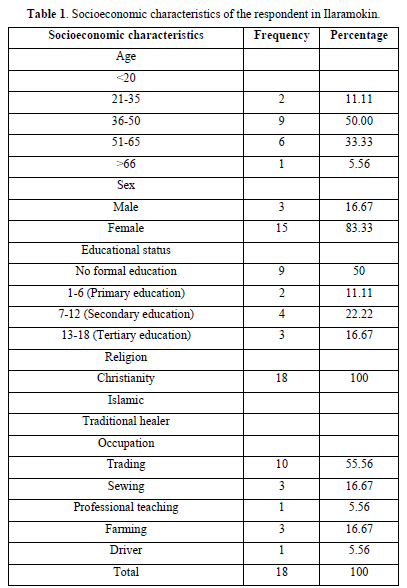
Seven botanicals were identified in the study belonging to 4 families and containing different parts of the plants. The different botanicals were used to treat different diseases of poultry bird species (Table 2).
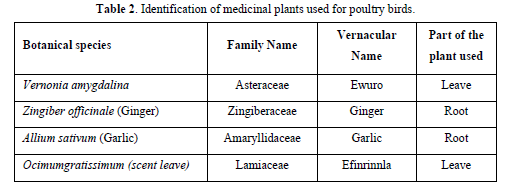
The most common diseases of the poultry bird in the village were watery diarrhea and there were other diseases of the poultry bird depending on the species (Tables 3 & 4).
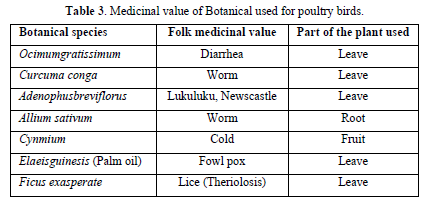
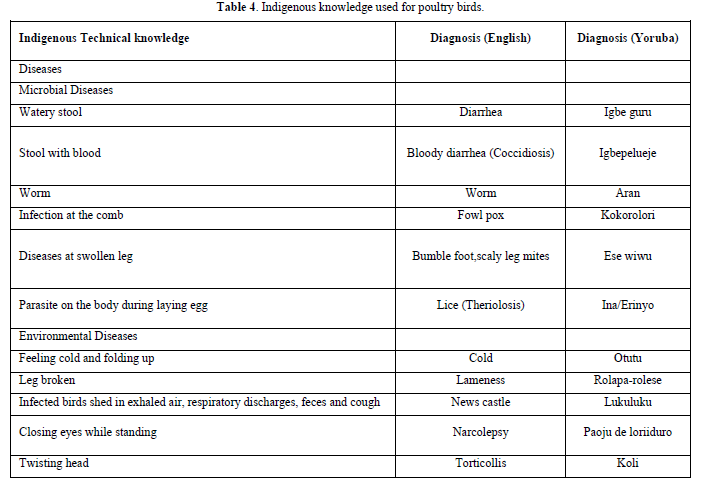
The different breed include: Domestic fowl, Chicken and Agric with specific color
In Table 5:
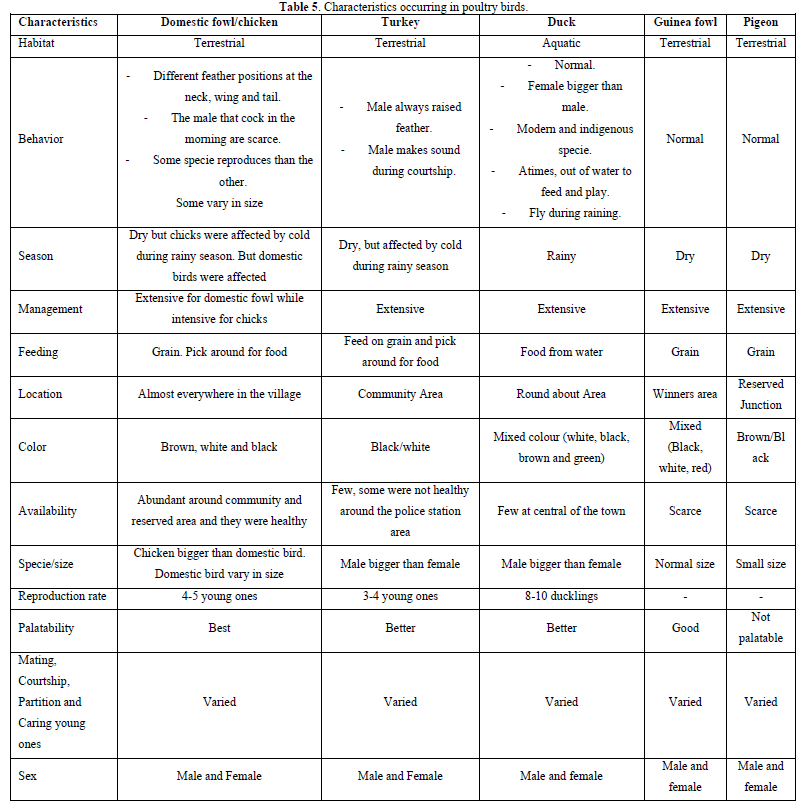
DISCUSSION
Some of the socioeconomic characteristics discovered in this study were related to study from [1,3]. The female with 36-50 ages that had no formal education and that were Christian and traders reared the domestic bird the most. This could be due to that they have time and they don’t have much money available with them to do orthodox medicine with the poultry bird. Some of the medicinal plants and value determined in this study was related to that determined by Adeola [1] which include Ocimumgratissimum and Vernonia amgydalina. The new botanicals found in this study include Garlic, Itagiri, ginger which was also found in the study [9]. The lameness and diarrhea of the birds discovered in this study was related to the study from [10,11]. The most common disease of poultry bird is cold, that can affect chicken, turkey and duck [4]. Fowl pox was also discovered in this study [12].
Most of the poultry birds were terrestrial except in ducks which were aquatic. Most of their behavior was normal except in domestic fowl that cock in the morning and the turkey that raised the feather during courtship. Most of the poultry birds were active during the dry season than rainy season. They practiced extensive system of hosing most in the villages and the birds feed on cereal crops like guinea corn, maize and so on. The domestic birds were randomly distributed within the village. The poultry bird varies in color. Some species of bird (duck, guinea fowl, turkey, and pigeon) were diminishing in the studied village as compared with ruminants from [3,4]. This shows that most species of poultry birds are going into extinction. The specie of domestic fowl that cock early in the morning and Agric onewas diminishing within the village [5]. Some few indigenous ducks were found within the village. While the specie of bird like guinea fowl and pigeon were scared within the village. The different feathers and reproduction found in the domestic fowl can be as a result of different species of domestic fowl that can be affected by different genetic makeup of the birdie the different characters of Domestic fowl are based on their molecular basis. Some of the male specie was bigger than the female.
The growth rate, resistance to diseases, reproduction rate and palatability, availability differences size, feather variation, color, tallness and comb variation between domestic fowl and broiler can be due to molecular composition of the birds.
The reproduction rate in poultry bird varied [7] also feeding in poultry bird in rural area is natural compared to urban area [8].
CONCLUSION
The study can be of economic importance to the state and the country, which can increase the meat production in poultry and income to the country if these poultry birds were preserved.
RECOMMENDATION
There is need for biodiversity conservation of medicinal plant and birds like diminishing domestic fowl (that cock early in the morning), indigenous duck, pigeon and guinea fowl within the villages through the provision of gene bank for the poultry birds and the research can be of ecological risk importance and need for policy making on consumption of diminishing poultry animals i.e. duck, pigeon and guinea fowl with in the villages.
No Files Found
Share Your Publication :